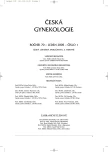Syndrome of Pseudomyxoma Peritonei – Description of Three Cases and Survey of the Problem
Authors:
Z. Kinkor 1; M. Michal 2
Authors‘ workplace:
Šiklův ústav patologie, LF UK, Plzeň, vedoucí prof. MUDr. M. Michal, PhD.
; Bioptická laboratoř, s. r. o., a Šiklův ústav patologie, LF UK, Plzeň, vedoucí prof. MUDr. A. Skálová, CSc.
Published in:
Ceska Gynekol 2005; 70(1): 67-72
Category:
Original Article
Overview
Objective:
To describe personal experience with three heterogeneous cases of pseudomyxoma peritonei. Review of the literature concentrates on the pathogenesis and biologic spectrum of the rare syndrome.
Design:
Three case reports.
Setting:
Private Biopsy Lab s.r.o. and Šikl’s Department of Pathology, Charles University and Faculty Hospital, Pilsen.
Methods and Results:
Included are cases from Biopsy Lab s.r.o. and from personal consulting registry of Prof. Michal, Šikl’s Department of Pathology, Pilsen. Clinical presentation of three cases of pseudomyxoma peritonei documented is in details including long follow up. Broad variability of histologic appearance associated with different Clinical outcome is demonstrated. Immunohistochemistry performed by streptavidin-biotin system (LSAB+, Dako) as detection system, and diaminobenzidin tetrahydrochlorid as chromogen, employed three monoclonal antibodies – MUC2 (Novocastra, 1:400), cytokeratin 7 (Dako, 1:200) and cytokeratin 20 (Dako, 1:100).
Conclusion:
Pseudomyxoma peritonei is a clinical syndrome defined as presence of massive mucinous, viscous material in the peritoneal cavity, both floating and adhering to serosal surface (jelly-belly). The histologic examination should always follow with detailed and precise description of the epithelial component. The cytological and structural quality of the epithelium constitutes two basic forms with entirely different nature biology and prognosis. First and more frequent, so-called disseminated peritoneal adenomucinosis, where primary low grade (benign) mucinous appendiceal tumor is almost constant finding, often recurs but displays favorable prognosis. Second, so-called peritoneal mucinous carcinomatosis is an extraordinary manifestation of peritoneal carcinosis following generalization of the gastrointestinal mucinous adenocarcinoma. Histopathogenesis in both types is thought to arise from MUC2 positive goblet cells in GI and ovarian involvement is secondary. A normal macroscopic finding on appendix or „uneventful“ appendectomy in anamnesis is not unusual.
Key words:
pseudomyxoma peritonei – mucinous cystadenoma – ovary – appendix – mucocele – mucin – peritoneum – disseminated peritoneal adenomucinosis – peritoneal mucinous carcinomatosis – „jelly-belly“
Labels
Paediatric gynaecology Gynaecology and obstetrics Reproduction medicineArticle was published in
Czech Gynaecology

2005 Issue 1
Most read in this issue
- Abdominal hysterectomy – Risk Factor in Development of Urinary Incontinence? Results of a Questionnaire Study
- Risk Factors of the 3rd and 4th Degree Tear during Delivery
- Syndrome of Pseudomyxoma Peritonei – Description of Three Cases and Survey of the Problem
- Contribution of Doppler Examination in Pregnancy at Risk of Alloimune Fetus Anemia
